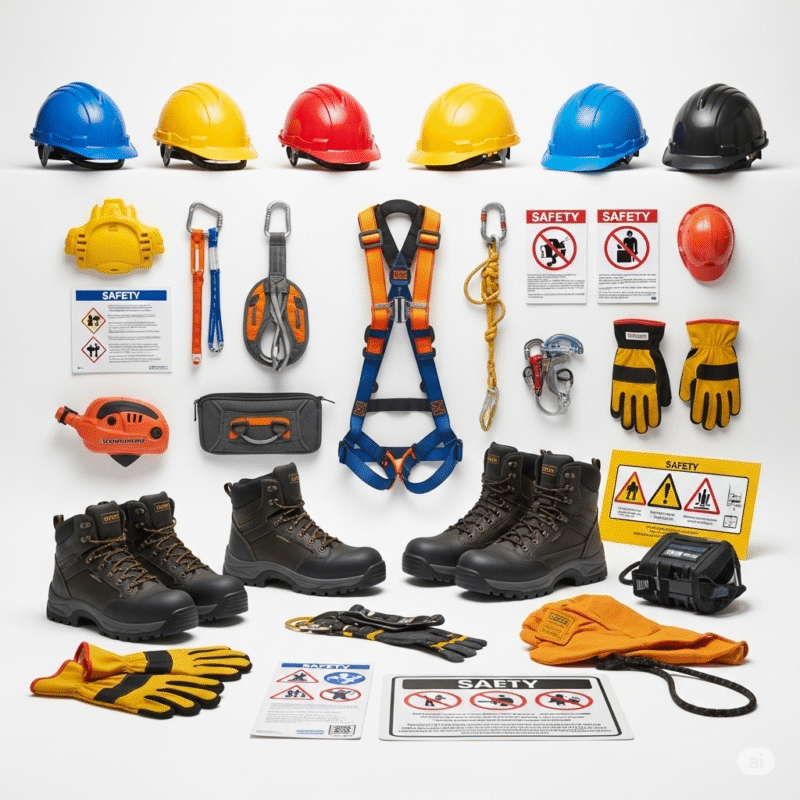Introduction – Labour Laws and Contractor Agreements
Labour laws and contractor agreements form the backbone of India’s construction industry, ensuring fair working conditions while protecting both employers and workers. Whether you’re a real estate developer planning your next project, a fresh graduate entering the construction field, or a homeowner building your dream house, understanding these legal frameworks is crucial for successful project execution.
The construction sector employs over 50 million workers in India, making it the second-largest employer after agriculture. With such massive workforce involvement, proper legal compliance isn’t just about avoiding penalties—it’s about creating sustainable, ethical business practices that benefit everyone involved.
Who Should Read This Guide?
- Construction professionals and project managers
- Real estate developers and investors
- Students working on construction-related projects
- Homeowners planning construction projects
- HR professionals in construction companies
- Legal advisors specializing in labour law
Key Methodologies & Processes
Legal Framework Foundation
The Indian construction industry operates under multiple legal frameworks that work together to ensure comprehensive worker protection and project compliance.
Primary Legal Acts:
- Indian Contract Act, 1872 – Establishes the basic validity and enforceability of contractor agreements
- Building and Other Construction Workers Act (BOCW), 1996 – Mandates registration and welfare cess collection
- Minimum Wages Act, 1948 – Ensures fair compensation through state-wise wage notifications
- Employees’ Provident Fund (EPF) & Employees’ State Insurance (ESI) Acts – Mandatory for contractors employing 20 or more workers

Step-by-Step Compliance Process
Pre-Contract Preparation
- Obtain necessary licenses and registrations
- Review current wage notifications
- Prepare compliance documentation
- Establish safety protocols
Contract Drafting
- Include all mandatory legal clauses
- Define clear scope of work
- Establish payment terms and schedules
- Set performance standards and penalties
Implementation
- Regular compliance monitoring
- Documentation maintenance
- Safety training programs
- Grievance handling procedures
Industry Standards and Codes
Indian Standards (IS) Codes Relevant to Labour Management:
- IS 3521: Safety helmets specifications
- IS 15674: Guidelines for construction site safety
- IS 4823: Code of practice for industrial safety
International Standards Integration:
- ILO (International Labour Organization) conventions
- ISO 45001 for occupational health and safety management
- Global best practices in worker welfare
Material & Manpower Requirements
Documentation Materials
Essential Legal Documents:
- Form V registration under BOCW Act
- Labour license from state authorities
- EPF and ESI registration certificates
- Minimum wage notification copies
- Safety compliance certificates
Record-Keeping Materials:
- Biometric attendance systems
- Digital wage slip generation software
- Safety training documentation templates
- Incident reporting forms
- Medical examination records
Manpower Structure
Administrative Personnel:
- Labour compliance officer
- Safety supervisor
- HR coordinator
- Legal advisor (on retainer)
Technical Requirements:
- Skilled supervisors (1 per 20 workers)
- Safety officers (1 per 500 workers)
- First aid trained personnel
- Grievance committee members
Technology Integration:
- Digital attendance tracking systems
- Payroll management software
- Safety monitoring applications
- Compliance dashboard tools
Deliverables at Each Stage
Pre-Construction Phase
Mandatory Deliverables:
- BOCW Act registration certificate
- Contractor license verification
- EPF/ESI registration documents
- Minimum wage compliance certificate
- Safety protocol documentation
Impact: Establishes legal foundation and prevents project delays due to compliance issues.
Construction Phase
Ongoing Deliverables:
- Monthly attendance registers
- Detailed wage slips with breakdown
- Safety training completion certificates
- Incident reporting logs
- Overtime calculation records
- Festival advance documentation
Impact: Ensures continuous legal compliance and maintains worker satisfaction throughout project duration.
Post-Construction Phase
Final Deliverables:
- Final settlement statements (within 48 hours)
- Completion certificates
- Safety audit reports
- Grievance resolution records
- Project compliance summary
Impact: Protects against future legal disputes and maintains company reputation for future projects.
Stakeholders & Communication Matrix
Key Stakeholders
Primary Stakeholders:
- Project developers and owners
- Contractors and subcontractors
- Construction workers and unions
- Government labour departments
- Safety inspectors
Secondary Stakeholders:
- Insurance providers
- Medical facilities
- Legal advisors
- Training institutes
- Equipment suppliers
Communication Protocols
Daily Communications:
- Morning safety briefings
- Attendance verification
- Incident reporting (if any)
- Supervisor updates
Weekly Communications:
- Wage payment schedules
- Safety training sessions
- Progress reports to authorities
- Grievance committee meetings
Monthly Communications:
- Compliance audit reports
- EPF/ESI contributions
- Safety performance reviews
- Stakeholder meetings
Value Engineering Opportunities
Cost-Saving Techniques
Digital Transformation:
- Implement cloud-based attendance systems to reduce administrative costs by 30%
- Use mobile apps for real-time safety reporting
- Automate payroll calculations to minimize errors and penalties
Training Optimization:
- Develop in-house safety training programs
- Cross-train workers for multiple skills
- Create peer-to-peer learning systems
Compliance Automation:
- Use software for automatic wage calculation
- Implement digital record-keeping systems
- Automate compliance reporting to government portals
Sustainable Alternatives
Worker Welfare Improvements:
- Provide air-conditioned rest areas during extreme weather
- Install water coolers and hydration stations
- Create recreational facilities for worker well-being
Environmental Compliance:
- Implement green construction practices
- Use eco-friendly safety equipment
- Adopt sustainable waste management for construction sites
Case Study: Metro Construction Project, Bengaluru
Project Overview
A 15-kilometer metro line construction project involving 500+ workers across multiple contractors, completed between 2022-2024.
Challenges Faced
- Multi-state workforce: Workers from five different states with varying wage expectations
- Complex subcontracting: 12 different specialty contractors requiring coordination
- Monsoon disruptions: Extended working hours during dry periods leading to overtime complications
- Safety incidents: Initial high accident rates due to inadequate training
Solutions Implemented
Centralized Compliance System:
- Single digital platform for all contractors
- Standardized wage structures across all trades
- Unified safety training curriculum
- Real-time compliance monitoring dashboard
Worker Welfare Initiatives:
- Multi-language safety training programs
- Festival bonus standardization
- Healthcare facility on-site
- Grievance redressal through mobile app
Technology Integration:
- Facial recognition attendance systems
- Digital wage slip distribution
- IoT-based safety monitoring
- Automated compliance reporting
Results & Key Takeaways
Quantifiable Results:
- 95% reduction in compliance violations
- 60% decrease in safety incidents
- 40% improvement in worker retention
- Zero labour disputes during project duration
Key Learnings:
- Early investment in compliance systems saves significant costs later
- Technology adoption improves both efficiency and worker satisfaction
- Regular stakeholder communication prevents most disputes
- Standardized processes across contractors ensure consistency
Risks & Mitigation Strategies
Common Legal Risks
Compliance Violations:
- Risk: Penalties ranging from ₹10,000 to ₹1 lakh per violation
- Mitigation: Monthly compliance audits and automated reporting systems
Wage Disputes:
- Risk: Labour court cases and project delays
- Mitigation: Transparent wage calculation and regular payments
Safety Incidents:
- Risk: Legal liability and project shutdown
- Mitigation: Comprehensive safety training and regular equipment maintenance
Preventive Measures
Risk Assessment Tools:
- Monthly compliance scorecards
- Safety incident trend analysis
- Worker satisfaction surveys
- Legal requirement tracking systems
Proactive Strategies:
- Regular legal updates training for management
- Emergency response protocols
- Insurance coverage for labour-related risks
- Relationship building with labour departments
Essential Clauses in Contractor Agreements
Scope of Work Definition
Clearly define all tasks including shuttering, masonry, electrical work, and finishing activities. Specify quality standards, timelines, and deliverable requirements for each phase.
Payment Terms Structure
- Frequency: Weekly payments for daily wage workers, monthly for salaried staff
- Deduction Policy: Clear guidelines for defect penalties and delay charges
- Bonus Provisions: Annual bonus calculations under Payment of Bonus Act
Workforce Management
- Skill Requirements: Specific ratios of skilled to unskilled workers
- Subcontracting Rules: Written approval requirements for further subcontracting
- Training Obligations: Mandatory safety and skill development programs
Health & Safety Obligations
- PPE Provision: Helmets, gloves, safety harnesses meeting IS 3521 standards
- Medical Facilities: On-site clinics for projects with 250+ workers
- Accident Reporting: 24-hour notification to authorities and insurance providers
Working Conditions Standards
- Working Hours: Maximum 48 hours per week as per Shops & Establishments Act
- Rest Intervals: Mandatory 30-minute breaks after 5 hours of work
- Special Provisions: Creche facilities for projects employing 50+ women workers
Compliance Checklist
Pre-Project Requirements
- Form V registration under BOCW Act
- State-specific labour license verification
- EPF and ESI registrations (for 20+ workers)
- Minimum wage notification compliance
- Safety equipment procurement and certification
Ongoing Compliance Monitoring
- Daily attendance verification through biometric systems
- Weekly wage payment with detailed slip generation
- Monthly safety training and drill documentation
- Quarterly compliance audit and reporting
- Annual bonus calculations and disbursement
Documentation Maintenance
- Digital attendance registers with backup systems
- Comprehensive wage records with tax deductions
- Safety training certificates and renewal tracking
- Incident reports with follow-up action documentation
- Grievance logs with resolution timelines
Conclusion & Key Takeaways
Understanding and implementing proper labour laws and contractor agreements is not just about legal compliance—it’s about building a sustainable construction industry that values human dignity and safety. The key to success lies in proactive planning, technology adoption, and continuous stakeholder engagement.
Critical Success Factors:
- Early compliance planning prevents costly violations
- Technology investment improves efficiency and accuracy
- Regular communication with all stakeholders prevents disputes
- Comprehensive documentation protects against future legal challenges
Future Trends:
- Increased digitization of compliance processes
- Stricter enforcement of safety regulations
- Greater focus on worker welfare and retention
- Integration of AI and IoT in labour management
By following these guidelines and maintaining a commitment to ethical practices, construction professionals can create projects that not only meet legal requirements but also contribute to the industry’s positive evolution.




